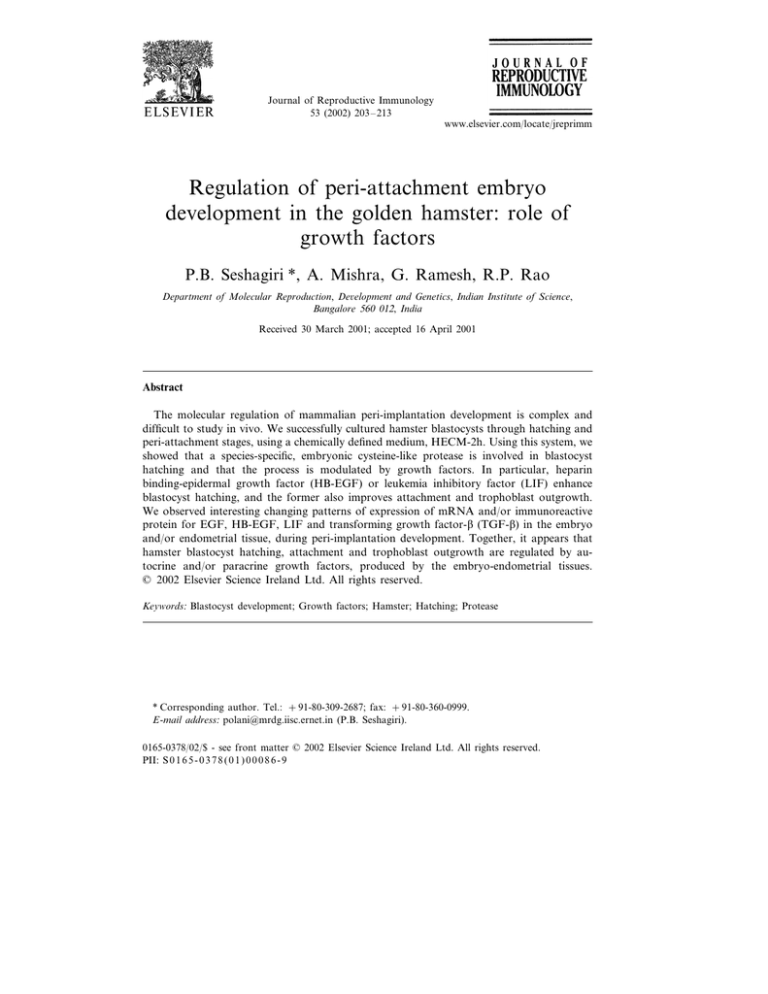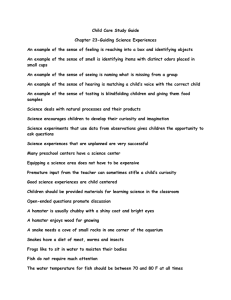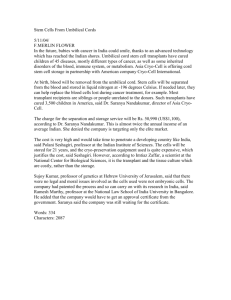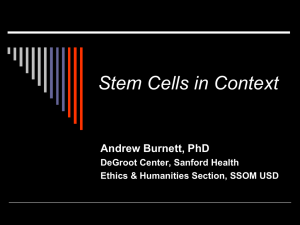
Journal of Reproductive Immunology
53 (2002) 203– 213
www.elsevier.com/locate/jreprimm
Regulation of peri-attachment embryo
development in the golden hamster: role of
growth factors
P.B. Seshagiri *, A. Mishra, G. Ramesh, R.P. Rao
Department of Molecular Reproduction, De6elopment and Genetics, Indian Institute of Science,
Bangalore 560 012, India
Received 30 March 2001; accepted 16 April 2001
Abstract
The molecular regulation of mammalian peri-implantation development is complex and
difficult to study in vivo. We successfully cultured hamster blastocysts through hatching and
peri-attachment stages, using a chemically defined medium, HECM-2h. Using this system, we
showed that a species-specific, embryonic cysteine-like protease is involved in blastocyst
hatching and that the process is modulated by growth factors. In particular, heparin
binding-epidermal growth factor (HB-EGF) or leukemia inhibitory factor (LIF) enhance
blastocyst hatching, and the former also improves attachment and trophoblast outgrowth.
We observed interesting changing patterns of expression of mRNA and/or immunoreactive
protein for EGF, HB-EGF, LIF and transforming growth factor-b (TGF-b) in the embryo
and/or endometrial tissue, during peri-implantation development. Together, it appears that
hamster blastocyst hatching, attachment and trophoblast outgrowth are regulated by autocrine and/or paracrine growth factors, produced by the embryo-endometrial tissues.
© 2002 Elsevier Science Ireland Ltd. All rights reserved.
Keywords: Blastocyst development; Growth factors; Hamster; Hatching; Protease
* Corresponding author. Tel.: + 91-80-309-2687; fax: + 91-80-360-0999.
E-mail address: polani@mrdg.iisc.ernet.in (P.B. Seshagiri).
0165-0378/02/$ - see front matter © 2002 Elsevier Science Ireland Ltd. All rights reserved.
PII: S 0 1 6 5 - 0 3 7 8 ( 0 1 ) 0 0 0 8 6 - 9
204
P.B. Seshagiri et al. / Journal of Reproducti6e Immunology 53 (2002) 203–213
1. Introduction
During mammalian embryogenesis, the zygote undergoes a series of
changes forming a blastocyst. Prior to implantation (attachment) into the
uterine endometrium, the blastocyst hatches from its zona pellucida (zona).
These peri-implantation events are rate limiting and critical for the establishment of pregnancy. Low implantation rates of in vitro fertilized (IVF)
human embryos are largely due to impaired development and hatching of
blastocysts (Magli et al., 1998). Little, however, is known about their
molecular regulation, primarily because of difficulties in studying them in
vivo. For this, in vitro embryo development models are necessary, but they
are constrained by inadequacies of culture systems, in particular, the
suboptimal culture media and the low percentage development of hatched
and attached blastocysts from cleavage-stage embryos (Bavister, 1995;
Seshagiri et al., 1999).
To study peri-attachment embryo development, the golden hamster is one
of the useful models. Because preimplantation development can be achieved
using chemically defined culture media and cleavage-stage embryos are
extremely sensitive to culture conditions (Seshagiri and Bavister, 1989a,b,
1991a,b; McKiernan and Bavister, 1990; Bavister, 1995; Mishra and Seshagiri, 1998), hamster embryos could be exploited to test media components
and regulators on peri-implantation development. Moreover, the mechanism of hatching (Kane and Bavister, 1988a,b; Gonzales and Bavister, 1995;
Gonzales et al., 1996; Mishra and Seshagiri, 1998) and the hormonal
requirement for implantation (Evans and Kennedy, 1980) are quite different
in this species, compared to other mammals. In this article, we summarize
the past and ongoing research efforts to understand early hamster
development.
2. Development of blastocysts through peri-attachment stages
In the last decade, extensive attempts were made by systematically
optimizing physiochemical and media components to achieve normal and
viable in vitro development of hamster preimplantation embryos (Seshagiri
and Bavister, 1989a,b, 1991a,b; McKiernan and Bavister, 1990; Barnett and
Bavister, 1992; Seshagiri et al., 1999). An important discovery has been the
detrimental effect of glucose and inorganic phosphate on embryo development (Schini and Bavister, 1988; Seshagiri and Bavister, 1989a,b, 1991a).
For supporting development of 8-cell embryos to blastocysts, hamster
embryo culture medium (HECM)-2 was formulated (Seshagiri and Bavister,
1989b). By supplementing 0.5 mM succinate and 0.01 mM malate to
P.B. Seshagiri et al. / Journal of Reproducti6e Immunology 53 (2002) 203–213
205
HECM-2, 100% development of high quality, biologically viable blastocysts
was achieved (Ain and Seshagiri, 1997). This, however, failed to support
blastocyst hatching. Interestingly, supplementation of succinate, amino
acids, vitamins (inositol, pantothenate, choline chloride) and bovine serum
albumin (BSA) to HECM-2 supported 100% development of hatched
blastocysts (Fig. 1) and this new medium was designated as HECM-2h; h,
hatching (Mishra and Seshagiri, 1998).
In HECM-2h, all blastocysts deflated and hatched from focally lysed
zonae, which underwent complete dissolution (Fig. 1). Omission of BSA
from HECM-2h failed to support hatching, while that of vitamins reduced
it (Mishra and Seshagiri, 1998). Blastocysts, having the potential to undergo
hatching in HECM-2h, were of high quality as they had higher mean cell
number (MCN) than that of blastocysts developing in BSA-free HECM-2h.
Besides, the MCN of cultured blastocysts was superior to that of in vivo
developed blastocysts (35.291.6 vs. 17.691.0, PB0.001; Mishra and
Seshagiri, 1998). Cell allocation, i.e., trophectoderm (TE) to inner cell mass
Fig. 1. Photomicrographs of cultured zona-intact hamster blastocyst (A), blastocysts undergoing zona lysis (B, C) and an azonal blastocyst (D). Note the partial (B, C) or complete (D)
disappearance of zona and also bristle-like trophoectodermal projections on the periphery of
embryos (B,C). Bar =25 mm. (Photographed with Nomarski optics, × 20).
206
P.B. Seshagiri et al. / Journal of Reproducti6e Immunology 53 (2002) 203–213
(ICM) ratio in blastocysts, remained unaltered in both media (Mishra and
Seshagiri, 1998). But HECM-2h neither supported attachment of hatched
blastocysts nor trophoblast (TB) outgrowth. Surprisingly, when 10% bovine
fetal serum (BFS) was supplemented to HECM-2h, it was detrimental to the
development of blastocysts and none of them hatched. Interestingly, however, BFS was required either as a supplement to HECM-2h or as a coating
on dishes for azonal blastocysts to efficiently attach and exhibit TB outgrowth (Mishra and Seshagiri, 1998; Seshagiri et al., 1999). It appears that
serum supplementation to culture medium has a differential effect on
hamster embryo development, depending on the stage of embryos exposed
to serum.
3. Blastocyst hatching and involvement of embryonic protease
The phenomenon of hamster blastocyst hatching, both in vivo and in
vitro (Kane and Bavister, 1988a,b; Gonzales and Bavister, 1995; Gonzales
et al., 1996; Mishra and Seshagiri, 1998), has been studied. Unlike those in
other species, hamster blastocyst hatching mechanisms observed in vitro are
distinct and closely mimic those in vivo. These include 100% blastocysts
development and hatching; blastocysts undergoing deflation followed by a
focal zona thinning preceding focal zona rupture and embryos then crawling out of the hemizona case, accompanied by a complete zona dissolution
(Fig. 1); and azonal blastocysts efficiently attaching and exhibiting trophoblast outgrowth. Moreover, preblastocyst-stage embryos also exhibit
zona lysis. In this regard, the culture medium, HECM-2h appears to be the
best so far as the in vitro development of peri-attachment hamster blastocysts is concerned (Mishra and Seshagiri, 1998). Unlike in hamsters, in the
mouse/rat (Bergstrom, 1972; Surani, 1975; Seshagiri et al., 1999), cow
(Massip and Mulnard, 1980), rhesus monkey (Seshagiri and Hearn, 1993)
and human (Lopata and Hay, 1989), hatching occurs by a different mechanism. Fully expanded blastocysts exert hydrostatic (mechanical) pressure
creating a nick in the zona, through which they egress, leaving the empty
zona intact. Moreover, evidence for the source of zona lytic protease has
been equivocal. Both blastocysts (Denker and Fritz, 1979; Perona and
Wassarman, 1986; Menino and Williams, 1987; Sawada et al., 1990; Vu et
al., 1997) and uterus (Joshi and Murray, 1974; Denker, 1977) have been
shown to produce zona lysin.
In hamsters, the complete dissolution of zona during blastocyst hatching
observed in vitro strongly indicates a potent zona lytic factor of embryonic
origin. Unequivocal lines of evidence to support this are the following.
When freshly recovered 2-cell embryos were co-cultured with hatching-blas-
P.B. Seshagiri et al. / Journal of Reproducti6e Immunology 53 (2002) 203–213
207
tocysts, the former exhibited partial/complete zona lysis; also, co-cultured
pre-morula (1– 8-cell) stage embryos. However, zonae from mice, rats, sheep
and humans were resistant to lysis, indicating that the hamster zona lysin
could be species-specific (Mishra and Seshagiri, 2000a). Unlike from other
species, zonae from hamsters were found to be extraordinarily susceptible to
pronase. Interestingly, cysteine protease inhibitors, viz., antipain, leupeptin,
E-64 and p-hydromercuribenzoate, completely inhibited hatching of cultured blastocysts without affecting their development, while inhibitors to
other types of proteases had either modest or no curtailment of hatching.
Moreover, the chemical means of zona dissolution, for example, by reactive
oxygen species (ROS), appeared unlikely, since cultured blastocysts exhibited zona lysis despite the presence of superoxide dismutase or catalase,
scavengers of ROS (Mishra and Seshagiri, 2000a). These observations show
that blastocyst-derived zona lytic protease(s) is responsible for hatching in
hamsters. However, the cell type producing this activity and its regulation
remain to be investigated (see below).
We believe that uterine zona lysin involvement in blastocyst hatching in
vivo is either minimal or negligible in hamsters since (i) luminal flushings
and endometrial extracts from day 4 (=zona escape in vivo) pregnant
females fail to lyse zonae in vitro; and (ii) transferred 2-cells or blastocysts
to uterus of day 3 pseudopregnant females fail to exhibit zona escape,
despite residing in the uterus for 12 h (Mishra and Seshagiri, 2000a). Taken
together, these observations indicate the existence of species-specific, blastocyst-derived potent proteolytic factor(s), with a cysteine protease like activity, responsible for hatching of hamster blastocysts.
4. Role of growth factors during peri-attachment development
A number of studies document growth factors having embryotrophic
effects (Paria and Dey, 1990; Harvey et al., 1995; Kane et al., 1997; Sargent
et al. 1998); others, such as chemokines, cytokines, adhesion molecules and
proteinases in peri-implantation development (Kauma, 2000; Simon et al.,
1996). Because striking features are observed with development and hatching of blastocysts (Gonzales and Bavister, 1995; Mishra and Seshagiri, 1998,
2000a; Seshagiri et al., 1999), and virtually nothing is known about the role
of growth factors in hamster development, we studied the involvement of
epidermal growth factor (EGF), heparin binding-EGF (HB-EGF), transforming growth factor-b (TGF-b) and leukemia inhibitory factor (LIF)
during hamster peri-attachment development. We chose them since they
have been shown to be important regulators of development of blastocysts
and implantation in other systems (Harvey et al., 1995; Simon et al., 1996;
Sargent et al., 1998).
208
P.B. Seshagiri et al. / Journal of Reproducti6e Immunology 53 (2002) 203–213
Fig. 2. Influence of growth factors, EGF, HB-EGF, TGF-b and LIF on hamster blastocyst
hatching. Values shown are mean 9 SEM for six replicate experiments each with a minimum
of 40–45 embryos per treatment. The bars represent total hatching, i.e. partial and complete
zona lysis, and the hatched portions in each bar represent complete zona lysis. Values with
identical superscripts differ significantly (PB 0.05). Values corresponding to HB-EGF are
reproduced from Mishra and Seshagiri (2000b) with permission from Reproductive Health
Care Ltd., UK.
Supplementation of any of the factors, viz., EGF, HB-EGF, TGF-b and
LIF or their respective antibodies, to HECM-2h did not influence blastocyst
development over the untreated control; all treatments showed blastocyst
development in the range of 89–99% of control. Addition of growth factors
moderately increased MCNs and their values were 3192 (EGF), 2891
(HB-EGF), 359 3 (TGF-b) and 3591 (LIF) compared to 2792 for
untreated controls. Treatment of antibodies to cultured embryos reduced
their MCNs uniformly; values were 2091 (anti-EGF), 2793 (anti-HBEGF), 18 9 1 (anti-TGF-b) and 2091 (anti-LIF) compared to non-immune
IgG-treated controls (229 1). Interestingly, however, addition of growth
factors to the medium modulated hatching of cultured blastocysts. In
particular, HB-EGF and LIF profoundly accelerated hatching with complete dissolution of zona, occurring at an early time point, i.e. 36 h (Fig. 2,
hatched bars in respective treatments). The beneficial effect of growth
factors on blastocyst hatching could be markedly curtailed by their respective antibodies, but not by non-immune-IgG (Fig. 3), thus indicating that
the observed effects are growth factor-specific and developmental event-specific. Besides, addition of HB-EGF increased blastocyst attachment and also
markedly increased TB outgrowth (Mishra and Seshagiri, 2000b).
Our unpublished data of northern blot/RT-PCR and immunocytochemical analyses of hamster uterine tissue samples indicate that mRNAs of
P.B. Seshagiri et al. / Journal of Reproducti6e Immunology 53 (2002) 203–213
209
EGF, HB-EGF, TGF-bs and LIF are variably expressed on days 1–6 of
pregnancy (day 4= time of implantation). Thereafter, the levels fall by days
5 – 6 of pregnancy. The protein profile of immunoreactive EGF, HB-EGF
and LIF is similar to mRNA profile (Mishra, Rao and Seshagiri, unpublished). During estrous cycle, their mRNAs (TGF-b) are maximally expressed on metestrous or diestrous stages, thereby, indicating that the
uterine expression of these growth factors is likely to be regulated by
progesterone and that the role of estradiol could be minimal (Ramesh,
Kondaiah and Seshagiri, unpublished). Immunoreactive HB-EGF and
TGF-bs could also be localized in blastocysts (Mishra and Seshagiri, 2000b;
Ramesh et al., unpublished). We believe that the interesting changing
patterns of expression of mRNA and/or immunoreactive protein in the
embryo-endometrial tissues for HB-EGF, TGF-b and LIF must be crucial
for peri-implantation development in hamsters.
The possible autocrine/paracrine effects involving these factors could be
brought about either directly or indirectly via inducing the expression of
Fig. 3. Influence of antibodies to growth factors, EGF, HB-EGF, TGF-b and LIF on
hamster blastocyst hatching. Values shown are mean 9 SEM for six replicate experiments
each with a minimum of 35 –40 embryos per treatment. The bars represent total hatching.
Values with identical superscripts (a –d) differ significantly (PB 0.05); while for e, P \0.05.
Values corresponding to anti-HB-EGF are reproduced from Mishra and Seshagiri (2000b)
with permission from Reproductive Health Care Ltd., UK.
210
P.B. Seshagiri et al. / Journal of Reproducti6e Immunology 53 (2002) 203–213
Fig. 4. A hypothetical model showing molecular regulators of embryo-endometrial origin
involved in protease-mediated blastocyst hatching. Abbreviations used are epidermal growth
factor (EGF), heparin binding-EGF (HB-EGF), transforming growth factor-b (TGF-b) and
leukemia inhibitory factor (LIF).
other molecular mediators, thereby hastening development. Moreover,
growth factors could be influencing/augmenting the embryonic expression
of zona lysins (protease) from either mural or polar TE cells (Fig. 4). At this
time, we do not know whether the zona lytic activity is cell membrane
bound, presumably with TE-projections (Fig. 1; Gonzales et al., 1996), or
secreted into the peri-vitelline space for inducing zona lysis (Fig. 4). These
exciting cellular and molecular mechanisms remain to be examined in
hamster development. Based on what is known in most mammals examined,
including humans (Paria and Dey 1990; Das et al., 1994; Kane et al.,
1997; Martin et al., 1998; Sargent et al., 1998; Tawada et al., 1999), it is
becoming clear that embryonic growth factors have major autocrine/
paracrine roles to play during blastocyst development, differentiation and
implantation.
P.B. Seshagiri et al. / Journal of Reproducti6e Immunology 53 (2002) 203–213
211
5. Conclusion
The hamster embryo development system, using HECM-2h which supports maximal development of hatched-blastocysts with potential to attach
and exhibit TB outgrowth, could provide new avenues for gaining insights
into the cellular and molecular regulation of pre-/peri-implantation development. It appears that HB-EGF and LIF profoundly regulate hatching and
peri-attachment blastocyst development with other embryo-endometriumderived regulators potentially controlling early development via autocrine
and/or paracrine mechanisms.
Acknowledgements
Financial support from the Department of Science and Technology, New
Delhi is gratefully acknowledged. The authors thank Dr M. Klagsbrun,
Harvard Medical School, Boston, MA, USA, for kindly providing the
HB-EGF antibody; Ms H.S. Lalitha for technical support and Ms M.S.
Padmavathi for her help during the preparation of the manuscript.
References
Ain, R., Seshagiri, P.B., 1997. Succinate and malate improve development of hamster
eight-cell embryos in vitro: confirmation of viability by embryo transfer. Mol. Reprod.
Dev. 47, 440 –447.
Barnett, D.K., Bavister, B.D., 1992. Hypotaurine requirement for in vitro development of
golden hamster one-cell embryos into morulae and blastocysts, and production of term
offspring from in vitro-fertilized ova. Biol. Reprod. 47, 297 –304.
Bavister, B.D., 1995. Culture of preimplantation embryos: facts and artifacts. Hum. Reprod.
1, 91–148.
Bergstrom, S., 1972. Shedding of the zona pellucida of the mouse blastocyst in normal
pregnancy. J. Reprod. Fert. 31, 275 –277.
Das, S.K., Wang, X.N., Paria, B.C., et al., 1994. Heparin-binding EGF-like growth factor
gene is induced in the mouse uterus temporally by the blastocyst solely at the site of its
apposition: a possible ligand for interaction with blastocyst EGF-receptor in implantation. Development 120, 1071 –1083.
Denker, H.W., 1977. Implantation. The role of proteinases, and blockage of implantation by
proteinase inhibitors. Adv. Anat. Embryol. Cell Biol. 53, 3 –123.
Denker, H.W., Fritz, H., 1979. Enzymatic characterization of rabbit blastocyst proteinase
with synthetic substrates of trypsin-like enzymes. Hoppe Seylers Z. Physiol. Chem. 360,
107–113.
Evans, C.A., Kennedy, T.G., 1980. Blastocyst implantation in ovariectomized, adrenalectomized hamsters treated with inhibitors of steroidogenesis during the peri-implantation
period. Steroids 36, 41 –52.
212
P.B. Seshagiri et al. / Journal of Reproducti6e Immunology 53 (2002) 203–213
Gonzales, D.S., Bavister, B.D., 1995. Zona pellucida escape by hamster blastocysts in vitro
is delayed and morphologically different compared with zona escape in vivo. Biol.
Reprod. 52, 470 –480.
Gonzales, D.S., Boatman, D.E., Bavister, B.D., 1996. Kinematics of trophectoderm projections and locomotion in the peri-implantation hamster blastocysts. Dev. Dyn. 205,
435–444.
Harvey, M.B., Leco, K.J., Arcellana-Panlilio, M.Y., Zhang, X., Edwards, D.R., Schultz,
G.A, 1995. Roles of growth factors during peri-implantation development. Mol. Hum.
Reprod. 10, 712 –718.
Joshi, M.S., Murray, I.M., 1974. Immunological studies of the rat uterine fluid peptidase. J.
Reprod. Fertil. 37, 361 –365.
Kane, M.T., Bavister, B.D., 1988a. Protein-free culture medium containing polyvinyl alcohol, vitamins and amino acids supports development of eight-cell hamster embryos to
hatching blastocysts. J. Exp. Zool. 247, 183 –187.
Kane, M.T., Bavister, B.D., 1988b. Vitamin requirements for development of eight-cell
hamster embryos to hatching blastocysts in vitro. Biol. Reprod. 39, 1137 –1143.
Kane, M.T., Morgan, P.M., Coonan, C., 1997. Peptide growth factors and preimplantation
development. Hum. Reprod. Update 3, 137 – 157.
Kauma, S.W., 2000. Cytokines in implantation. J. Reprod. Fertil. Suppl. 55, 31 –42.
Lopata, A., Hay, D.L., 1989. The potential of early human embryos to form blastocysts,
hatch from their zona and secrete hCG in culture. Hum. Reprod. 4, 87 – 94.
Magli, M.C., Gianaroli, L., Ferraretti, A.P., Fortini, D., Aicardi, G., Montanaro, N., 1998.
Rescue of implantation potential in embryos with poor prognosis by assisted zona
hatching. Hum. Reprod. 13, 1331 – 1335.
Martin, K.L., Barlow, D.H., Sergent, I.L., 1998. Heparin-binding epidermal growth factor
significantly improves human blastocyst development and hatching in serum-free
medium. Hum. Reprod. 13, 1645 –1652.
Massip, A., Mulnard, J., 1980. Time-lapse cinematographic analysis of hatching of normal
and frozen-thawed cow blastocysts. J. Reprod. Fertil. 58, 475 – 478.
McKiernan, S.H., Bavister, B.D., 1990. Environmental variables influencing in vitro development of hamster 2-cell embryos to the blastocyst stage. Biol. Reprod. 43, 404 –413.
Menino, A.R. Jr., Williams, J.S., 1987. Activation of plasminogen by the early bovine
embryo. Biol. Reprod. 36, 1289 –1295.
Mishra, A., Seshagiri, P.B., 1998. Successful development in vitro of hamster 8-cell embryos
to ‘zona-escaped’ and attached blastocysts: assessment of quality and trophoblast outgrowth. Reprod. Fertil. Dev. 10, 413 –420.
Mishra, A., Seshagiri, P.B., 2000a. Evidence for the involvement of species-specific embryonic protease in zona dissolution of hamster blastocysts. Mol. Hum. Reprod. 6, 1005 –
1012.
Mishra, A., Seshagiri, P.B., 2000b. Heparin binding-epidermal growth factor improves
blastocyst hatching and trophoblast outgrowth in the golden hamster. Reprod. BioMed.
Online 1, 87–95.
Paria, B.C., Dey, S.K., 1990. Preimplantation embryo development in vitro: cooperative
interactions among embryos and role of growth factors. Proc. Natl. Acad. Sci. USA. 87,
4756–4760.
Perona, R.M., Wassarman, P.M., 1986. Mouse blastocysts hatch in vitro by using a
trypsin-like proteinase associated with cells of mural trophoectoderm. Dev. Biol. 114,
42– 52.
P.B. Seshagiri et al. / Journal of Reproducti6e Immunology 53 (2002) 203–213
213
Sargent, I.L., Martin, K.L., Barlow, D.H., 1998. The use of recombinant growth factors to
promote human embryo development in serum-free medium. Hum. Reprod. 13, 239 –248.
Sawada, H., Yamazaki, K., Hoshi, M., 1990. Trypsin-like hatching protease from mouse
embryos: evidence for the presence in culture medium and its enzymatic properties. J.
Exp. Zool. 254, 83 –87.
Schini, S.A., Bavister, B.D., 1988. Two-cell block to development of cultured hamster
embryos is caused by phosphate and glucose. Biol. Reprod. 39, 1183 – 1192.
Seshagiri, P.B., Bavister, B.D., 1989a. Glucose inhibits development of hamster 8-cell
embryos in vitro. Biol. Reprod. 40, 599 –606.
Seshagiri, P.B., Bavister, B.D., 1989b. Phosphate is required for inhibition by glucose of
development of hamster 8-cell embryos in vitro. Biol. Reprod. 40, 607 – 614.
Seshagiri, P.B., Bavister, B.D., 1991a. Glucose and phosphate inhibit respiration and
oxidative metabolism in cultured hamster eight-cell embryos: evidence for the ‘Crabtree
effect’. Mol. Reprod. Dev. 30, 105 –111.
Seshagiri, P.B., Bavister, B.D., 1991b. Relative developmental abilities of hamster 2- and
8-cell embryos cultured in hamster embryo culture medium-1 and -2. J. Exp. Zool. 257,
51–57.
Seshagiri, P.B., Hearn, J.P., 1993. In vitro development of in vivo produced rhesus monkey
morulae and blastocysts to hatched, attached, and post-attached blastocyst stages:
morphology and early secretion of chorionic gonadotrophin. Hum. Reprod. 8, 279 –287.
Seshagiri, P.B., Mishra, A., Krishnamurthy, G., 1999. Regulation of development of
peri-attachment embryos: comparative studies in rodents. In: Gupta, S.K. (Ed.), Reproductive Immunology. Narosa Publishing Home, New Delhi, pp. 110 –120.
Simon, C., Gimeno, M.J., Mercader, A., Frances, A., Velasco, J.G., Remohi, J., Polan,
M.L., Pellicer, A., 1996. Cytokines-adhesion molecules-invasive proteinases. The missing
paracrine/autocrine link in embryonic implantation? Mol. Hum. Reprod. 2, 405 –424.
Surani, M.A.H., 1975. Zona pellucida denudation, blastocyst proliferation and attachment in
the rat. J. Embryol. Exp. Morphol. 33, 343 –353.
Tawada, H., Higashiyama, C., Takano, H., et al., 1999. The effects of heparin-binding
epidermal growth factor-like growth factor on preimplantation-embryo development and
implantation in the rat. Life Sci. 64, 1967 – 1973.
Vu, T.K.H., Liu, R.W., Haaksma, C.J., Tomasek, J.J., Howard, E.W., 1997. Identification
and cloning of the membrane-associated serine protease, hepsin, from mouse preimplantation embryos. J. Biol. Chem. 272, 31315 –31320.




